The term "4Cs" in diamond quality refers to the four main characteristics used to evaluate and grade diamonds. These characteristics are universally recognized and determine a diamond's quality and value. The 4Cs are:
Cut
The cut of a diamond has a significant impact on its overall appearance and how it interacts with light. A well-cut diamond is expertly crafted to optimize its brilliance, fire, and scintillation, which are the terms used to describe the diamond’s sparkle, dispersion of light, and flashes of color.
When a diamond is cut to precise proportions and angles, light enters the diamond and is reflected internally multiple times before returning to the observer’s eye. This process maximizes the amount of light that exits the top of the diamond, resulting in exceptional brilliance and sparkle.
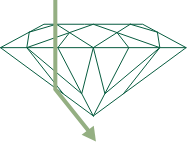
Shallow
A shallow cut diamond allows light to escape from its sides instead of reflecting off its top.

Excellent / Ideal
This premier cut style is well-proportioned and carefully angled to achieve a luminous appearance.

Deep
Diamond whose cut is too deep will look smaller than diamonds of similar carat weight.
The cut grade of a diamond is determined based on its proportions, symmetry, and polish. The Gemological Institute of America (GIA) assigns cut grades ranging from Excellent, Very Good, Good, Fair, to Poor.
GIA Cut Scale
GIA Cut Scale
Excellent
Very Good
Good
Fair
Poor
It's important to note that the cut grade should not be confused with the diamond's shape, such as round, princess, or emerald. The cut grade specifically refers to the quality of how the diamond has been cut and faceted, rather than its overall shape or appearance.
Carat Sage only sells Good or Above Cuts
We do not carry “Fair” and “Poor” cut diamonds due to lack of shine or brilliance, displaying a glass-like or dull appearance, and generally lacking visual appeal.
Colour
It refers to the presence of any colour tint in a diamond, which can range from colourless to light yellow or brown.
In the case of white diamonds, the less colour they exhibit, the higher their value. The Gemological Institute of America (GIA) uses a colour grading scale that starts with the letter D (colourless) and goes all the way to Z (light yellow or brown). Diamonds in the D to F range are considered colourless or nearly colourless, and they are highly valued due to their rarity and exceptional brightness.
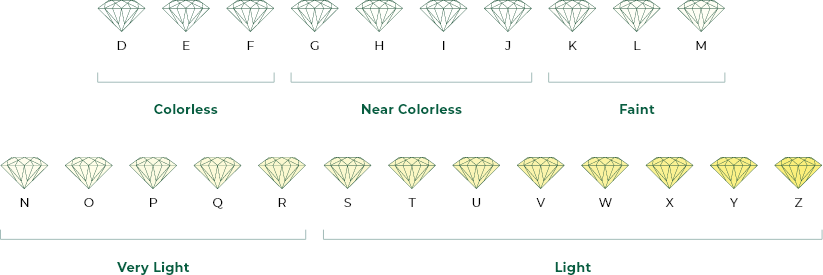
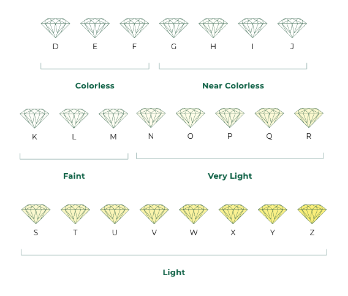
As the grading scale progresses from G to Z, the presence of yellow or brown tints becomes more noticeable. The colour differences between grades are often subtle and require expert assessment by gemologists who compare diamonds against a set of master stones of known colour grades.
At Carat Sage, our diamonds only range from D (Colourless) to K (Faint). We do not carry diamonds from L to Z colour range due to noticeable distinct warm yellow tone that falls short of the quality and value criteria upheld by Carat Sage.
Clarity
Clarity is the presence or absence of internal or external flaws, known as inclusions and blemishes respectively.
Inclusions are naturally occurring internal characteristics within a diamond, such as tiny crystals, mineral deposits, or fractures. Blemishes, on the other hand, are external imperfections that occur on the surface of the diamond, including scratches, nicks, or pits.
Clarity grading takes into account the size, nature, location, visibility, and quantity of these imperfections. The Gemological Institute of America (GIA) uses a clarity grading scale consisting of six main categories:

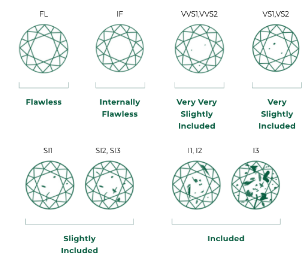
Flawless (FL): Diamonds in this category have no internal or external flaws visible under 10x magnification. These diamonds are exceedingly rare and highly valued.
Internally Flawless (IF): These diamonds have no internal flaws but may exhibit some insignificant external blemishes that are not visible under 10x magnification. They are also considered rare and of excellent quality.
Very, Very Slightly Included (VVS1 and VVS2): Diamonds in this category contain minute inclusions that are extremely difficult to detect even under 10x magnification. They are of high quality and offer excellent value.
Very Slightly Included (VS1 and VS2): These diamonds have minor inclusions that are somewhat visible under 10x magnification but are generally not visible to the naked eye. They offer a good balance between quality and value.
Slightly Included (SI1 and SI2): Diamonds in this category have noticeable inclusions that may be visible under 10x magnification and sometimes to the naked eye. However, they still provide good value, especially if the inclusions are located towards the edge or back of the diamond.
Included (I1, I2, and I3): Diamonds in this category have inclusions that are readily visible to the naked eye and may affect the overall appearance and transparency of the stone. They are typically the least expensive and may have reduced brilliance.
Carat
Carat is a unit of measurement used to quantify the weight of a diamond. One carat is equivalent to 200 milligrams or 0.2 grams.
Carat weight is one of the four main characteristics used to assess the quality and value of a diamond.

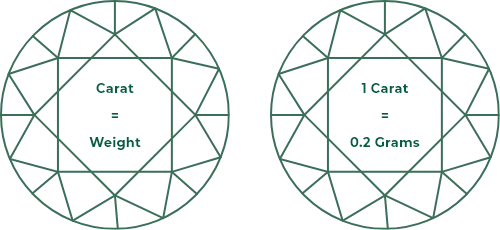
Carat weight is an essential factor because larger diamonds are generally rarer and more valuable. However, it’s important to note that carat weight alone does not determine a diamond’s quality or beauty. The other three characteristics, known as the 4Cs (colour, clarity, and cut), also significantly impact a diamond’s overall desirability.
While carat weight relates to a diamond’s size, it’s important to understand that two diamonds with the same carat weight may appear different in size due to variations in their cut. For example, a diamond with a deeper cut may have more of its weight concentrated in the depth, making it appear smaller compared to a diamond with a shallower cut.
It’s also worth mentioning that the price of a diamond generally increases exponentially with carat weight. This is because larger diamonds are rarer and require more rough material to be mined and cut. As a result, the price per carat tends to rise as carat weight increases.
When choosing a diamond, it’s essential to strike a balance between carat weight and the other three characteristics. Ultimately, the selection should be based on personal preference, budget, and the desired balance of size and quality.
It’s worth noting that carat weight is only one aspect of a diamond’s overall value and beauty. A smaller diamond with excellent cut, color, and clarity can still be visually stunning, while a larger diamond with lower cut, color, or clarity may not exhibit the same level of brilliance and sparkle.